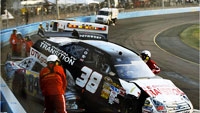Confusion in the air over DTV transition

The FCC’s $350,000 sponsored NASCAR racecar was designed to promote the DTV transition. In November, however, the car crashed during a NASCAR event in Phoenix. Could it be a forewarning of the future of DTV in America?
Critics argue, that despite a major marketing campaign that includes nightly ads on TV, the race car disaster accurately reflects the state of the DTV education effort.
Consumers Union, a consumer advocacy group that also publishes “Consumer Reports” magazine, found in a survey that while 90 percent of the nation is aware of the transition, 25 percent mistakenly believe that one must subscribe to cable or satellite to receive television reception after February.
Another 41 percent think that every TV in a house must have a new converter box, even those that are already connected to cable or satellite.
Many involved in the transition, to take place Feb. 17, believe it will leave millions of Americans bewildered when their TVs stop working. The fear is that those least likely to understand or afford the transition — such as the poor, the elderly and the non-English speaking — will be most affected.
“This transition is possibly one of the worst understood consumer education programs in modern times,” Richard Doherty, an analyst with the Envisioneering Group, told the “New York Times.”
“On Feb. 18, there will be a tremendous amount of finger-pointing.”
The professional video industry's #1 source for news, trends and product and tech information. Sign up below.
While the government and industry have invested large sums to get the message out, critics say the problem is that the effort is too little and way too late.
